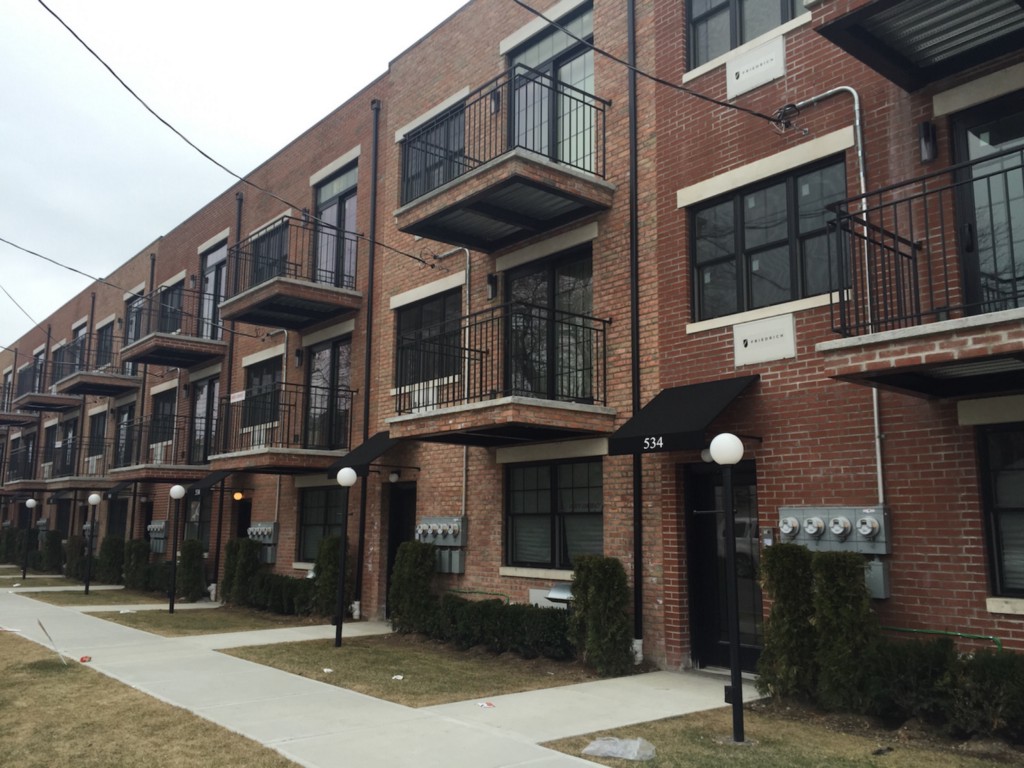Upon This Blockchain
Upon This Blockchain
The unavoidable dinner table discussion topic of Easter, 2015: Would Jesus use Bitcoin?
Get The New East India Youth Record
I am wary of isolating any one track from this album because it contains so very many layers that a single song will only offer an incomplete picture of just what an astounding achievement the whole thing is, but I understand that you probably want to hear something before investigating further, so here is a song from East India Youth’s Culture of Volume. The whole thing is remarkable record made all the more impressive by how its seemingly incompatible pieces not only fit together, but both support and enhance their adjacent works. Alexis Petridis in the Guardian did a good job of describing just how well it all assembles:
[F]or all that you’re never quite certain what Culture of Volume is going to do next, it never sounds ragged or incoherent. Nor does it ever feel like the kind of exercise in smart-arsed affectation that enables people who like smart-arsed affectation in music to apply the prefix “meta” to it: behold my ingenious generic juxtapositions, everyone, aren’t I clever? Instead, it connects with listeners on a very basic, emotional level. It’s not just that the melody and lyrics of Carousel are really moving; it’s that the shift from the preceding track’s dancefloor euphoria to this song’s epic melancholy amplifies its effect.
The influences are all fairly obvious: Berlin-era Bowie, Scott Walker, Brian Eno, Kraftwerk, Neil Hannon, Pet Shop Boys, some Thomas Dolby — if those names put you off then I guess you should avoid, but otherwise I cannot urge you more strongly to give this one a series of repeated listens. It’s nice to know that records like this can be made.
New York City, April 2, 2015

★★★★★ Brightness coming sideways from the east inked most of the raised letters of the Martin Luther King Jr. quotes — “human dignity” — on the rusted-steel sculpture outside the high school. Indoors had been nauseatingly stuffy, but now, outdoors, it was time for the new light jacket, over the new discount-priced cotton-blend sweater. On the way back uphill from the preschool, leaving the river winds behind, it was time for the jacket, in its first day of service, to come off. Bright dust drifted in the stairway up to Prince Street. The sun was both soft and dazzling. All around, coat fronts were hanging awkwardly unfastened, or the coats were already slung over arms. A girl exited the school door and thrust up an arm, with a shout of “Spring is here!” The seven-year-old swapped out his quilted parka for a hoodie and set off to fetch his brother from preschool, bouncing and thrumming. It was like June, he said. A marvel. A knot of school safety police broke into an intermittent trot toward some sort of trouble by the bodega. A police van joined them; a youth on a bench across the way, watching the fuss, carefully lifted off his ballcap and reversed it. The three-year-old held up his Batman figures to the open apartment window to try to make their capes blow in the breeze, and was tearfully disappointed to be discouraged from dangling one out past the sill, over the twenty-seven-story drop. He was going to stay there in the little space by the window, he said, till he stopped being sad. It was not long. The shirts of winter went into the washing machine for a long, purgative soak cycle. A golden contrail slowly slackened and below it an airplane laid down a new clean silver-blue one. A restaurant had opened while no one was paying attention, so why not order sandwiches? Why not skip the delivery button? The children put their shoes back on and headed out into the evening without even a hint of complaint.
The Ultimate Amazon Product

When a new startup promises to change some part of the economy, it usually gets the benefit of the doubt. It’s small! It shares your frustration with, say, laundromats, or, if it’s really smart, shows you a problem with laundromats that you hadn’t considered before. It’s on your side, both of you aligned against those incumbent inconvenience-makers.
This is a strange ritual. It gives startups leeway to try more daring things; additionally, it gives them permission to flout any expected conventions of behavior, be they regulations, ethics, or mere manners. It also suppresses certain lines of thought. It encourages you to imagine what the world will be like when you can do [thing] with your phone — or even when [thing] happens automatically, without any input at all. It drafts behind the wonder of this possibility. It discourages you, however, from imagining what it means that this promise will be fulfilled by a particular company run by particular people with particular ambitions and ideas about the world.
Amazon creates a lot of startup-like things. But its motives and goals, after over twenty years of operation, are not less open to interpretation. Imagine if a small startup, or a Kickstarter, offered a way to re-buy household staples with a small wireless button. You might not take it seriously! Even if you did, your mind would not necessarily race to a scenario in which toilet paper buying buttons are both taken for granted and controlled by a single commercial entity. You would allow space for this thing to be silly or cool or interesting and this would be easy because the question it asks about the future seems so narrow. Making the case for the inevitability of toilet paper buttons would be the startup’s accomplishment; your credulity — after all, you’ve been shown the future! — would be its prize.

Amazon’s button, introduced this week, asks a large set of additional questions about the toilet paper button future: How can Amazon create new forms of customer lock-in? How can Amazon develop new and profitable relationships with brands (which it may eventually replace with its own brands)? How close to full retail automation can Amazon come without alienating its customers? Amazon is admirably clear in its intention to become a logistics machine the likes of which the world has never seen. Its fixation on efficiency over profit is usually characterized as a rare example of true long-term planning, but it is better understood as a fixation on solving systems: an expression of a philosophy that demands not just the domination of a market, but the destruction of its appeal to competitors. It’s an economist’s dream, a business that has been allowed by investors to effectively operate as a non-profit dedicated to economic perfection. How does the button figure into that?
When Amazon shows us the future — when it can convince us, through cleverness or force of will, that it has discovered a new inevitability — it is also telling us that the future belongs, again, to Amazon.

This week, Amazon took its Home Services program national:
Amazon Home Services is a new and simple way to buy and schedule professional services such as furniture assembly, house cleaning, and lawn care directly on Amazon. We’ve handpicked the best service providers in your neighborhood and require all service pros to be background checked, insured, and licensed if applicable. Service pros compete for your business based on price, quality, and availability. If customers find a lower price for the same service and pro, we will match it. Pre-packaged services have upfront prices so you can add a service right to your cart. No special sign up or subscription is required. Your Amazon account is only charged after the service is completed. And best of all, all services are backed by Amazon’s Happiness Guarantee. If you’re not 100% satisfied, Amazon will make it right or give you a full refund.
Offers in my ZIP code include: voice lessons ($45, half hour); car stereo installation (~$100); a wide range of electrical, plumbing and repair services; and home cleaning ($99 for two hours). The selection is large enough to feel like a local directory; as a product, it clearly aspires to be the accountable, interactive Yellow Pages that the internet seemed to guarantee but never quite produced.
Where a smaller, newer company might focus on one logistical problem — gathering and vetting services OR providing a payment system for services — Amazon attempts to solve all of them at once. Based on a two-decade stretch of unbroken examples, we may assume that Amazon is not so much interested in participating in local economies as in managing and eventually replacing them. A consumer perception that finding a plumber is annoying is fairly well aligned with Amazon’s institutional perception that local service economies are, taken as system, spectacularly inefficient, and that an Amazon-run local economy would be better optimized. Amazon’s pitch, that “service pros” will now “compete for your business based on price, quality, and availability” suggests an orderly state of affairs in which power has been transferred back to you, the customer, away from variously competent and self-interested small businesses. Meanwhile, Amazon takes its commission, both at the time of sale and from the relationship: it gains as much, if not more, power than you do, presiding over your transaction with gentle but absolute control. If Amazon Home Services succeeds — if it becomes, for lack of a better term, the Amazon of local service jobs — this power multiplies.

Startup culture is shared tolerance for cognitive dissonance. It is small companies making their cases for various inevitabilities; it is these same companies suggesting that they are what makes these inevitabilities possible. Startup culture is writing straight-talk blog posts about the future on your venture capital firm’s blog; startup culture is the ability to read VC straight-talk as densely coded strategy. Startup culture is a constant case for the sanctity of efficiency, which is its own reward; startup culture is rewarding the reduction of inefficiencies with the highly visible creation of new ones. Startup culture is innately critical of everything outside of itself; startup culture, under scrutiny, questions the value of criticism. Startup culture is just simple business, plain as can be; startup culture is exceptional.
Amazon hasn’t been a startup in over a decade, so when it wears the costume of a startup the effect is uncanny. Magical inevitabilities, as delivered by Amazon, sound a little too much like potential future monopolies. This is the problem Amazon has with so many of its new products: They are easy to see for what they are. They often feel, first and foremost, like solutions to Amazon’s problems, not yours. The Fire Phone answered questions nobody outside of Amazon could possibly ask. The Amazon Dash button answers Amazon’s needs without clearly addressing any of its customers’ (but who knows, we’ll see). The Kindle, on the other hand, solved a logistical problem that was interfering with Amazon’s optimization of the books industry while also solving a number of problems book readers didn’t know they had.
Amazon has expressed its frustration with its dependence on humans in the highest court in the land, where it found sympathy. It has engineered its frustrations into robots and drones. It has made progress, certainly, but this progress has been frustratingly slow. Human friction keeps fucking up Amazon’s systems.
Home Services, then, represents a realization that Amazon has been approaching the problem of human labor at the wrong scale. It is not enough to treat it as waste that must be minimized. It can be embraced and made compliant with existing ecommerce systems. As long as it is necessary — for Amazon and for us — it may as well be packaged, inventoried, and sold. It can be shaped, subtly and slowly, into something a little easier to replace.
Past the Ditch
“Every writer of nonfiction who has struggled with the ditch and the bushes knows what [Joseph] Mitchell is talking about, but few of us have gone as far as Mitchell in bending actuality to our artistic will. This is not because we are more virtuous than Mitchell. It is because we are less gifted than Mitchell. The idea that reporters are constantly resisting the temptation to invent is a laughable one. Reporters don’t invent because they don’t know how to. This is why they are journalists rather than novelists or short-story writers. They depend on the kindness of the strangers they actually meet for the characters in their stories. There are no fictional characters lurking in their imaginations. They couldn’t create a character like Mr. Flood or Cockeye Johnny if you held a gun to their heads. Mitchell’s travels across the line that separates fiction and nonfiction are his singular feat. His impatience with the annoying, boring bits of actuality, his slashings through the underbrush of unreadable facticity, give his pieces their electric force, are why they’re so much more exciting to read than the work of other nonfiction writers of ambition.” — Janet Malcolm on, well, what else?
Have You Considered Moving Somewhere Else?

The new Census estimates show New York City’s population swelling to 8,491,079 people, a 52,700-person increase from the 2013 estimates (which were also revised upwards, or the increase would have been an even larger 85,242 people). Those numbers are up from a 2010 Census baseline of 8,175,133 people. But regardless of whether the 2010 number is correct, the latest estimates pose a problem for city planners, as the new 2014 number falls just under 60,000 people shy of the previous 2020 projection, of 8,550,971 people.
If you are still thinking of moving to New York for some reason, have you considered Canarsie?
Photo by Dan Phiffer
Thing That Is Not A Tech Company Is Actually A Tech Company, Says Company
“We’re starting to think of ourselves as an e-commerce company that sells pizza. So we can take a few more risks and lean forward a little more. E-commerce companies move fast and launch stuff and learn along the way.”
New York City, April 1, 2015

★ The skunk smell from a knot of teenagers carried half the width of the block and through the lobby doors. The new spring jacket had stayed in its delivery box. By the river, the cold bit into bare knuckles. The sky was a noncommittal blue to the west and a noncommittal white to the east; the light was waxy. Wool and down and fur filled the view up the stairs and out the subway exit. Unshared bikes filled the bike-share rack. Only the pigeons, courting on the ledge outside the office window, were noticeably feeling the springtime. The railing in the dark stairway gleamed as the late sun found it. A dirt-flecked puddle gleamed.
The Condos at the End of the Line
by Brendan O’Connor

540 East 87th Street #1, Canarsie
• $424,000
• Common Charges: $183; Monthly Taxes: $15
• 3 bedroom / 2.5 bathroom condo
• 1,350 square feet
• Nearest subway stop: L at Canarsie-Rockaway Parkway
On a dreary, late winter Monday, I met Moishe Loketch, the broad-shouldered, barrel-chested and Brooklyn-accented builder and developer who runs the Loketch Group with his father, Pinny, at their new luxury condo development in Canarsie. (For readers who have not taken the L train past Morgan Avenue, it is at the end of the line.) “We’re bringing affordable, quality housing to an underdeveloped neighborhood,” Loketch said as we began a tour of the property with his superintendent, Kwame. “We can cut corners anywhere here,” Moishe told me, proclaiming that the Loketch group doesn’t. “This kind of quality is unheard of in this area.” He pointed out the wallpaper, and the backsplash over the kitchen counter. “No one else builds in Canarsie like this.”
The Loketch Group — formerly the GLC Group — began developing low-end rentals and Section 8 housing in places like Harrisburg, Pennsylvania and East Orange, New Jersey in the mid-aughts before moving into New York, where Moishe told me they have developed, amongst other places, on North 4th and Driggs. Initially, the group developed low-income housing with the Community Preservation Corporation, a non-profit housing investment group that overextended itself during the last housing boom. “Now, the loans from CPC are not around anymore, we’re really funding this all out of pocket, mostly, just to provide affordable housing to the area at the right price, at the right finish,” Moishe said.
The Canarsie development, called Loft 87, is the Loketch Group’s tenth project in the neighborhood since the mid-nineties. (“We call it Loft 87 because it’s a little bit more contemporary-sounding,” Moishe said. “It’s obviously a regular apartment.”) The Loketch Group hasn’t constructed condos in Bushwick or Ridgewood because it doesn’t think there’s market there for buyers, yet — but they are looking to tempt renters from those neighborhoods into buying in Canarsie. “Why go to Bushwick and pay outta your nose when you can basically own — your mortgage on a unit like this will probably run you around fifteen to eighteen hundred dollars, depending on which one,” Moishe said. “So, you’re owning your apartment for eighteen hundred bucks instead of paying twenty five to three thousand dollars rent into garbage.” In Canarsie, he added, “I’m bringing everything you would see in Bushwick for half the price.”
“If we can just educate the Bushwick renter…” Moishe said, then trailed off. “Yes, you’re a student, yes, you may not be looking to settle down long-term, but the value that you get on your apartment — obviously, as we all know, real estate is always increasing as well — you’re developing and owning an asset. Not everyone has twenty grand down to put — students, journalists, artists, they make two, three grand a month but they don’t have the bulk payment to put it down — which is why most of them are renting, or because most of them don’t know where they’re gonna be from month to month.”
“Obviously, the popularity of the L train has brought more exposure to Canarsie I think, which is allowing for a trickle-in of gentrification into the area — which we are all for!” Moishe said. Gentrification takes time, however, so the Loketch Group has been marketing to residents who already live in the heavily West Indian neighborhood. “We see this area as really blue-collar, working class,” Moishe said. Kwame, Moishe’s superintendent, who was born in Granada and lives nearby, told me, “We’ve had a lot of teachers, nurses. You get a lot of people this is the first property they are purchasing.” After six months on the market, twenty out of twenty-seven units at Loft 87 are in contract. In another of the Loketch Group’s buildings, on Avenue I, a resident recently re-sold a unit for four hundred and sixty-nine thousand dollars; he had paid just four hundred and ten thousand dollars, Kwame said.
The Loketch Group still develops for the uneducated renters in Bushwick — which, in this conception, doesn’t just mean Bushwick proper, but also Ridgewood, East Williamsburg, the more remote parts of Greenpoint, Bed-Stuy, and honestly probably also much of Crown Heights — the Williamsburg Periphery, as it were — including, coincidentally, the building that I live in, in Ridgewood. “I’m the money behind that one,” Moishe said. Before the Loketch Group acquired and developed it, Moishe said, the building had been vacant for thirty years, the interior mostly collapsed. “We look for underdeveloped buildings in great areas,” he said. “We try to find the upside in property. I can’t afford to walk into Williamsburg and buy an A-class property. I can buy a piece of dirt and develop this; I can buy a dilapidated building and turn it into a beautiful structure.”
What makes (relatively) affordable new construction, like Loft 87, and renovations of buildings like the one I live in possible, developers like Moishe say, are tax abatements — the J-51 tax abatement, which the De Blasio administration has targeted, along with the 421a tax abatement set to expire this summer, as unduly benefiting developers. (The J-51 tax abatement subsidizes renovations; the 421a tax abatement subsidizes new development on underdeveloped land.) Unsurprisingly, Moishe has strong feelings about this: If the abatements are allowed to expire, another real estate crunch is inevitable. “You’re gonna have stalled projects again, you’re gonna have bank repossessions, you’re gonna have the same crash all over again. So, you just worked seven years to three percent, to get everybody to start developing, and now you’re going to pull the 421a and the J51? It seems, to the average man, ludicrous! Not if you’re Bill De Blasio.”
“Bring Mr. De Blasio down to this project and show him: I’m the quote-unquote one percent developer who is getting rich off the 421-a tax-abatement — that’s what they’re saying, is that the city could use 421-a tax abatement, why shouldn’t I pay the city so much money on such a project,” he said. The Association for Neighborhood and Housing Development found that the city missed out on over a billion dollars in tax revenue in Fiscal Year 2013 as a result of the tax abatement and that less than nine percent of units built under the program — or thirteen thousand units, according to Sheepshead Bites — were affordable. (Avenging angel Preet Bharara, the U.S. Attorney for New York, is reportedly investigating — amongst other things — the nearly thirty-five million abatement that subsidized billionaire tower One57.)
“First of all, I’d love for them to go see the books and do the math, how hard it is to make a dollar on a project like this to begin with. But aside from that, the real point is, the 421a tax-abatement is not profiting the developer; it’s profiting the end user of the low-income affordable housing,” Moishe said. The idea is that, by lowering the cost of development and construction, the state and city enable builders to offer a less-lucrative product — that is, lower-income housing. “Three hundred and fifty bucks a foot for a thousand square foot condo is as low-income as you’re gonna get. They don’t come lower than that, unless you got Missouri or Kansas.” (The average price per square foot in Brooklyn is seven hundred and eighty-nine dollars, according to a report released by the Corcoran Group for the fourth quarter of 2014.)
Without the tax abatements, Kwame said, “a lot of people won’t be able to afford to purchase. Even if you raise their mortgage by five hundred dollars, for some people, that’s a lot. If they take that away, that’s gonna be no good. No good.”
Have you noticed a real estate listing that you would like to have investigated? Send cool tips, fun listings, and hot gossip to brendan@theawl.com.
A Poem by Anthony Robinson
by Mark Bibbins, Editor
Resigned Authority
In the foreign head a fluorescence
making open a space for beautiful sentences —
as an authority as an authority please
surrender your embittered
male places. a swallow on the sill.
to flash & tumble this automaton this laundromat.
*
Post-identity, the begonias no longer know
whom to droop for: if this is fatherhood, more lightness please.
*
Build me a frame & around that frame build me a box
& around that box a cloudless sky & then a better frame.
Fall asleep an opening toward a better grave.
Anthony Robinson lives in the hinterlands of Oregon where he used to work in a call center for a corporate entity but got fired. His poems have appeared.
You will find more poems here. You may contact the editor at poems@theawl.com.
